If you’ve ever had to deal with burnt rice coming out of your rice cooker, you’re not alone. It can be frustrating to spend time cooking only to end up with rice that’s burnt or stuck to the bottom of the pot. Fortunately, with the right troubleshooting tips, you can avoid this problem and enjoy perfectly cooked rice every time.
Key Takeaways:
- A rice cooker burning rice is a common problem that can be easily avoided.
- Understanding the various cooking problems that can lead to burnt rice is essential.
- Proper cleaning and maintenance of your rice cooker can help avoid potential issues.
- Adjusting cooking modes and settings, and selecting the right rice cooker, can also help achieve perfectly cooked rice.
- Common mistakes can lead to burnt rice, but with these tips, you’ll be equipped to avoid them.
Understanding Rice Cooker Cooking Problems
Even the most experienced rice cookers can sometimes encounter problems with their device. Understanding the potential issues that can lead to improperly cooked rice can help troubleshoot rice cooker cooking problems, including the dreaded burnt rice.
Common Cooking Problems
There are several issues that can result in poorly cooked rice, including:
- Inadequate water levels
- Improper rice-to-water ratio
- Overcooking or undercooking
- Using the incorrect cooking mode
Each of these issues can cause rice to burn or come out undercooked, overcooked, or with an uneven consistency. Properly using the rice cooker, adjusting settings, and selecting the right cooking mode can help ensure your rice comes out consistently delicious.
Recognizing Your Rice Cooker Not Cooking Properly
If you notice your rice cooker consistently produces burnt, undercooked, or overcooked rice, there may be an issue with the device. Before troubleshooting, make sure to check the manufacturer’s instructions and warranty to avoid voiding the warranty.
If the device is still under warranty, it is best to contact the manufacturer for assistance. If the device is not under warranty, you can troubleshoot to identify and fix the issue. In the next section, we’ll discuss tips for preventing rice from burning in a rice cooker.
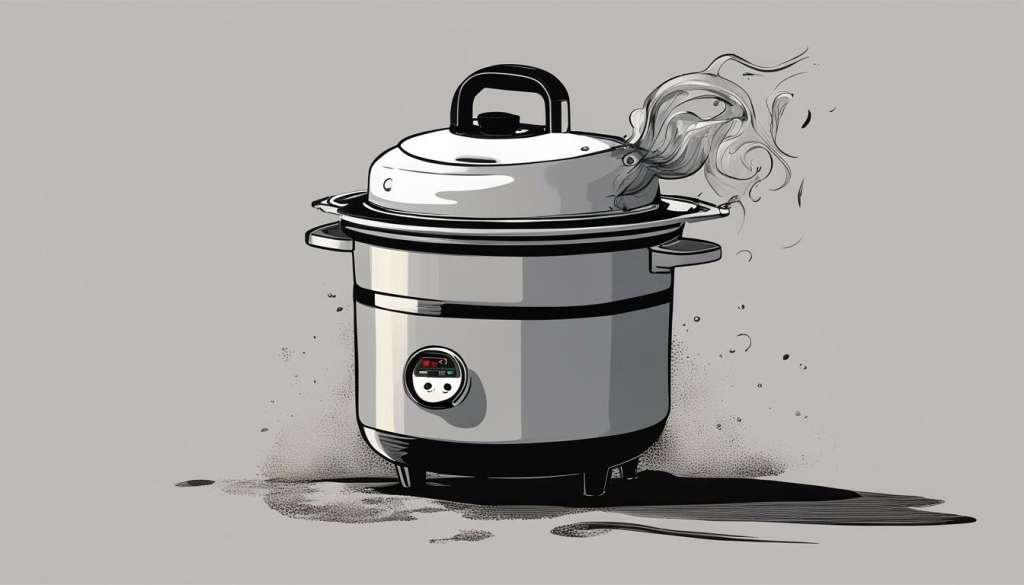
TIP: Always ensure the rice cooker is plugged into a grounded outlet, and avoid using extension cords or power strips. These can cause the rice cooker to not cook properly and potentially cause a safety hazard.
Tips for Preventing Rice from Burning in a Rice Cooker
Rice cookers are a convenient way to make delicious rice, but burning rice is a common issue that can be frustrating and spoil your meal. Here are some tips to help you prevent rice from burning in your rice cooker:
- Measure accurately: Using the correct proportions of rice and water is essential to achieve perfectly cooked rice. Use a measuring cup designed for rice and follow the water-to-rice ratio for your specific type of rice.
- Adjust water ratios: If you find that your rice is consistently too dry or too wet, adjusting the water ratio can be helpful. Use less water for drier rice and more water for softer rice.
- Use the right cooking mode: Many rice cookers come with different settings such as quick cook, brown rice, and porridge. Using the correct mode for your rice type can prevent burning and ensure even cooking.
- Let it soak: Soaking rice for 30 minutes before cooking can help prevent burning and ensure fluffier rice.
- Avoid opening the lid: Opening the lid during cooking can release steam and disrupt the cooking process, leading to unevenly cooked rice and burning.
- Keep the rice warm: After the rice has finished cooking, switch the rice cooker to the ‘warm’ setting. This will keep the rice at a safe temperature and prevent burning.
By following these tips and adjusting your cooking methods when necessary, you can prevent burnt rice in your rice cooker and enjoy delicious, perfectly cooked rice every time.
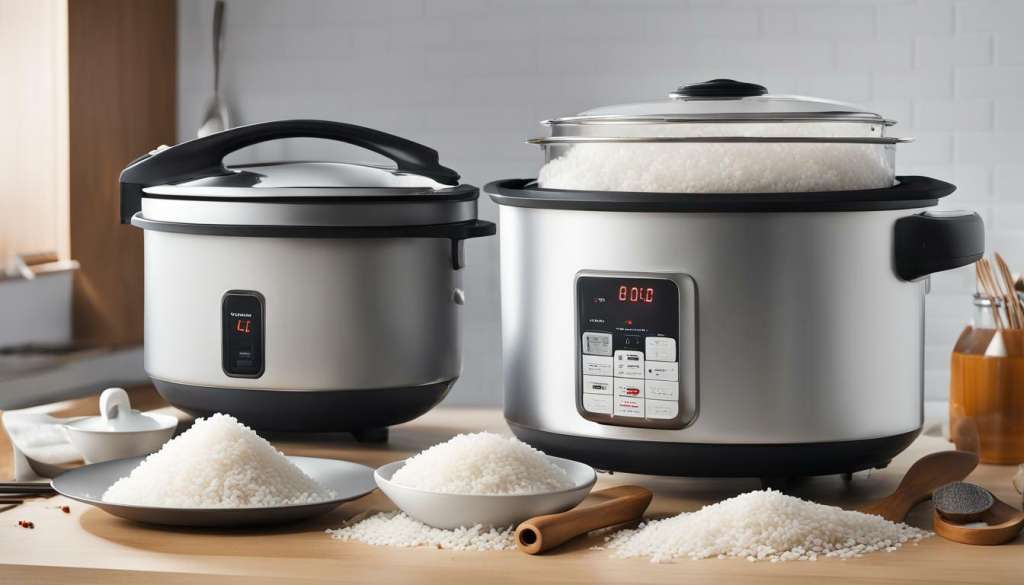
Troubleshooting Common Rice Cooker Issues
If you’re experiencing burnt rice in your rice cooker, it’s important to troubleshoot the issue to prevent it from happening again. Here are some common problems that can lead to burnt rice and how to fix them:
Rice cooker overheating
If your rice cooker is overheating, it can cause the rice to burn. One possible cause of overheating is a malfunctioning thermostat. To fix this, unplug the rice cooker and let it cool down. Then, use a multimeter to check the thermostat for continuity. If it’s not functioning properly, you may need to replace it.
Another possible cause of overheating is using the incorrect cooking mode or setting. Make sure you’re using the appropriate cooking mode for the type of rice you’re cooking and adjust the settings according to the instructions.
Rice cooker timer not working
If the timer on your rice cooker is not working, it can lead to burnt rice. One possible cause is a faulty timer. Check the timer and ensure it is set correctly. If it’s still not working, unplug the rice cooker and let it cool down. You may need to replace the timer.
Keep in mind that some rice cookers may not have a timer, in which case you’ll need to manually time the cooking process to prevent burnt rice.
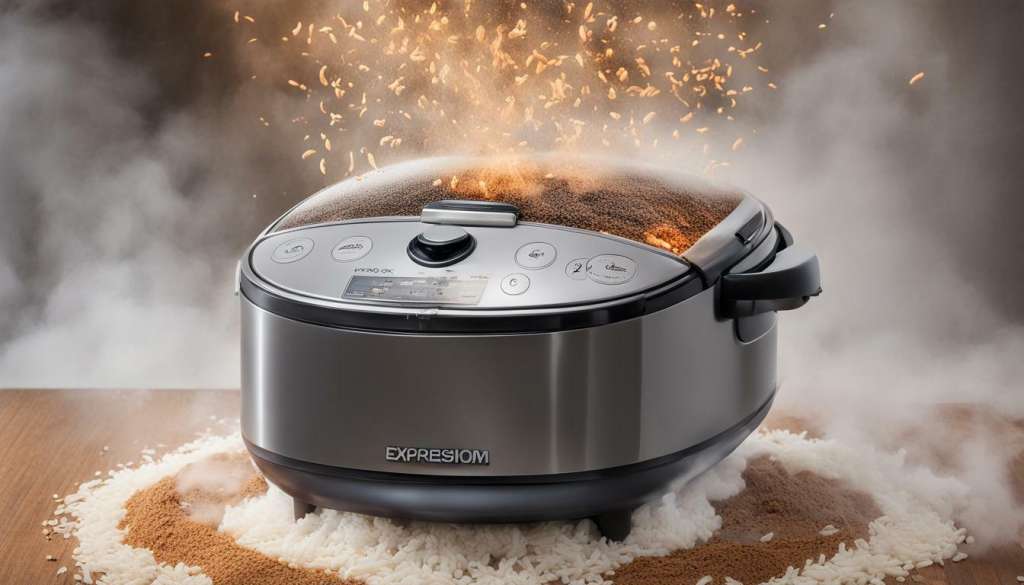
By understanding and troubleshooting common rice cooker issues, you can avoid burnt rice and enjoy perfectly cooked rice every time. If you’re still experiencing problems with your rice cooker, consult the manufacturer’s instructions or contact customer support for further assistance.
Selecting the Right Rice Cooker for Preventing Burnt Rice
Investing in the right rice cooker can make all the difference in preventing burnt rice. Here are some of the best rice cooker brands known for their ability to cook rice perfectly:
| Brand | Model | Features |
|---|---|---|
| Zojirushi | Neuro Fuzzy Rice Cooker | Microcomputer technology, multiple settings, keep-warm feature |
| Aroma | 8-Cup Digital Rice Cooker & Food Steamer | Digital display, programmable settings, steam tray for cooking other foods |
| Tiger | JNP-S10U-HU Rice Cooker | Non-stick inner pan, keep-warm function, simple one-touch button design |
When choosing a rice cooker that helps you achieve consistently well-cooked rice, consider the following features:
- The capacity you need to cook the amount of rice you typically eat
- The ability to cook other grains, such as quinoa or oats, if desired
- Different cooking modes, including quick cook and specific rice settings
- The quality of the inner pot and whether it has a non-stick coating
- The inclusion of a keep-warm function to maintain the temperature of your rice until you’re ready to eat
Remember that investing in a high-quality rice cooker can save you time and frustration in the long run. Don’t be afraid to spend a bit more to ensure consistently great rice every time.
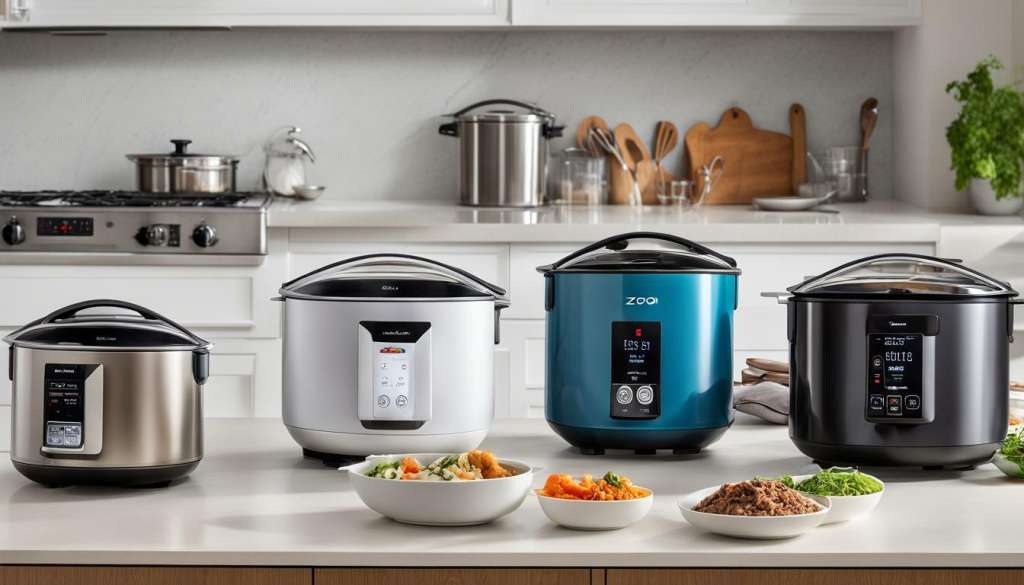
Proper Cleaning and Maintenance of Rice Cookers
Regular cleaning and maintenance of your rice cooker is crucial for achieving consistently well-cooked rice and extending the longevity of your appliance. Here are some essential tips to keep your rice cooker in top condition:
Rice Cooker Maintenance
After each use, make sure to unplug your rice cooker and allow it to cool completely before cleaning.
To clean the inner pot, first remove any remaining rice and rinse it with water. Next, use a soft sponge and a mild detergent to clean the pot, being careful not to scratch the non-stick coating. Avoid using abrasive pads or steel wool, as they can damage the surface of the pot.
For the exterior of the rice cooker, use a damp cloth to wipe down the surface, being careful not to get any water inside the appliance. Never immerse the rice cooker in water or spray it with water, as it can damage the electrical components.
Rice Cooker Cleaning Tips
If you notice any food residue or buildup inside your rice cooker, you can use a mixture of vinegar and water to clean it. Start by unplugging the rice cooker and allowing it to cool completely. Next, mix equal parts of white vinegar and water in the inner pot and let it soak for 30 minutes. Afterward, dispose of the mixture and rinse the pot with water.
Another option for cleaning a rice cooker is to use baking soda. Mix one tablespoon of baking soda with warm water to make a paste, then use a soft sponge to apply the paste to the inner pot. Let it sit for 10-15 minutes, then rinse thoroughly with water.
By following these maintenance and cleaning tips, you can ensure your rice cooker continues to function optimally, providing you with perfectly cooked rice for years to come.
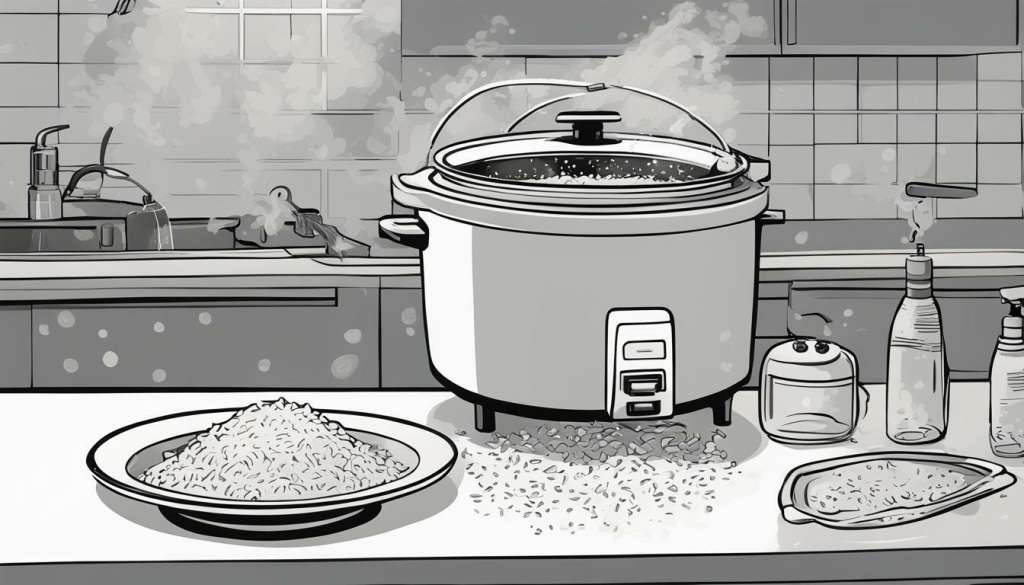
Cooking Tips for Perfectly Cooked Rice
While using a rice cooker is a convenient way to cook rice, some additional cooking tips can help you achieve perfectly cooked rice every time. Here are some helpful cooking tips to keep in mind:
- Rinse your rice: Rinse your rice before cooking to remove excess starch and help prevent clumping.
- Measure your water accurately: The ratio of water to rice is crucial for perfectly cooked rice. Use the measuring cup that came with your rice cooker and follow the manufacturer’s instructions.
- Let your rice rest: After the rice cooker has finished cooking, let the rice sit for 5-10 minutes before serving. This allows the steam to distribute evenly throughout the rice and create a fluffier texture.
- Fluff your rice: Use a fork to fluff your rice after it has rested. This helps to separate the grains and release excess moisture.
By following these simple cooking tips, you can elevate your rice cooking game and achieve perfectly cooked rice every time.
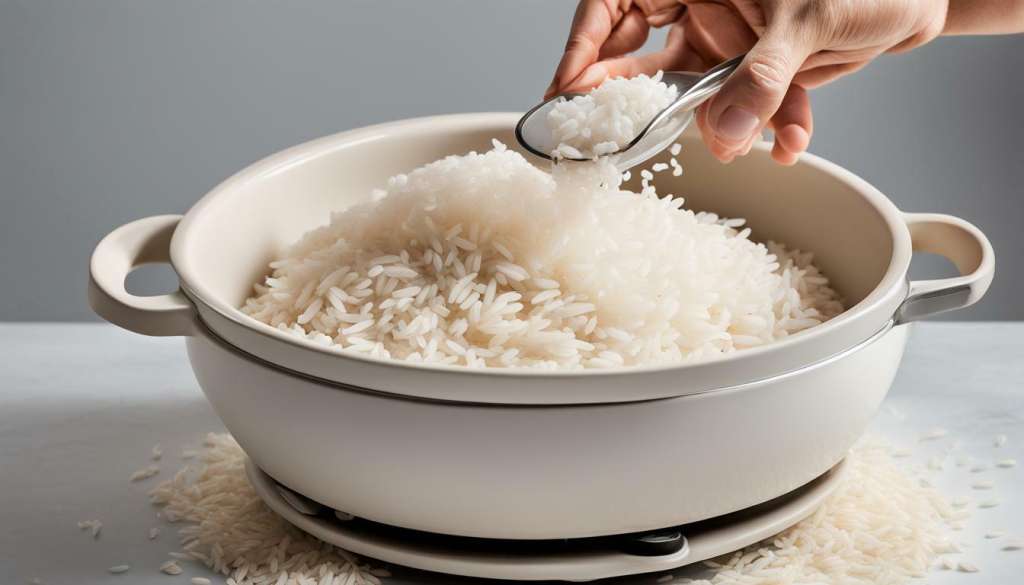
Exploring Rice Varieties and Water Ratios
Did you know that different types of rice require different water ratios for cooking? Understanding these ratios is essential for preventing burnt rice and achieving the perfect texture every time.
For example, short-grain rice varieties like sushi rice and arborio rice require more water than long-grain varieties like basmati or jasmine rice. Typically, a ratio of 1.5 to 1.75 cups of water per cup of short-grain rice will yield optimal results, while 1.25 to 1.5 cups of water per cup of long-grain rice is ideal.
Keep in mind that altitude and humidity can also affect water ratios, so it may take some experimentation to find the perfect ratio for your specific location.
It’s also important to rinse your rice thoroughly before cooking to remove excess starch and improve texture. Rinse until the water runs clear.
Use this handy chart as a reference to determine the optimal water ratio for your preferred rice variety:
| Rice Variety | Water Ratio |
|---|---|
| Short-grain (sushi, arborio) | 1.5-1.75 cups per cup of rice |
| Medium-grain (calrose, carnaroli) | 1.5-1.75 cups per cup of rice |
| Long-grain (basmati, jasmine) | 1.25-1.5 cups per cup of rice |
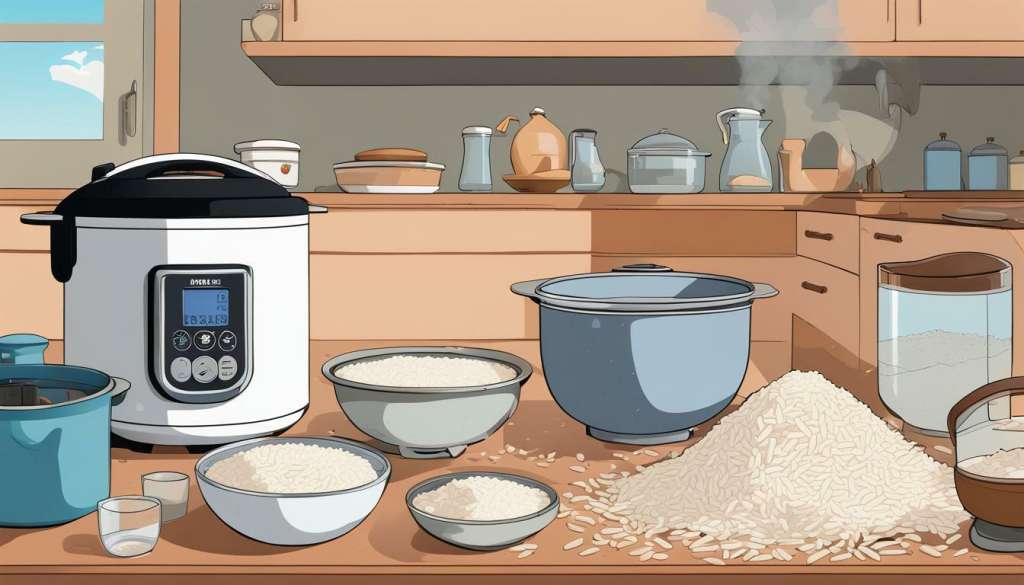
By understanding the water ratios for different rice varieties and using proper rinsing techniques, you’ll be well on your way to perfectly cooked rice every time.
Adjusting Cooking Modes and Settings
If you’re experiencing burnt rice in your rice cooker, it may be due to incorrect cooking modes and settings. Many rice cookers offer various cooking modes that can affect the cooking time and temperature.
First, check your rice cooker’s manual to understand the different modes available. Different rice types may require different modes or settings, so it’s essential to choose the correct mode for the rice you’re cooking.
| Rice Type | Ideal Mode |
|---|---|
| Short-grain white rice | Regular or White Rice mode |
| Long-grain white rice | Regular or White Rice mode |
| Basmati rice | Brown Rice mode |
| Brown rice | Brown Rice mode |
| Wild rice | Mixed Rice or Brown Rice mode |
It’s also crucial to adjust the water ratio according to your rice and the cooking mode you’re using. Some rice cookers come with pre-programmed settings for different rice types, but these settings may not always be accurate.
Experiment with adjusting the water ratio by small increments until you find the perfect ratio for your rice cooker. Generally, more water is needed for brown rice and less for white rice.
Finally, make sure to set the cooking time accurately to avoid overcooking or undercooking your rice. Some rice cookers have a timer function, which can be useful for ensuring your rice is cooked for the correct duration.
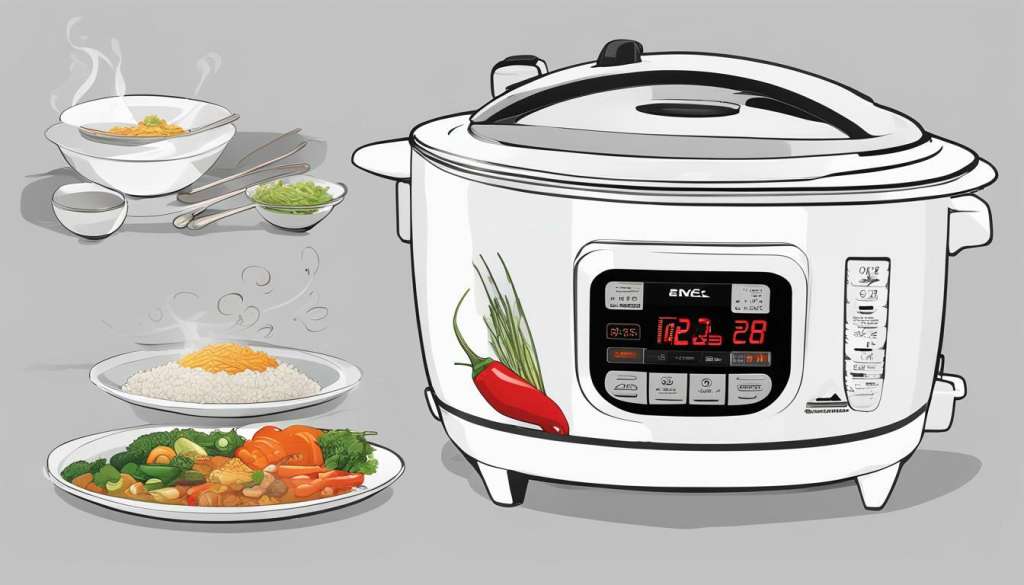
By adjusting your rice cooker’s cooking modes and settings, you can prevent burnt rice and achieve perfectly cooked rice every time.
Troubleshooting Rice Cooker Timer Issues
If your rice cooker timer is not working, it can lead to burnt rice, undercooked rice, or even no rice at all. Here’s what to do:
- Double-check that the rice cooker is plugged in properly and the outlet is working.
- Ensure that the timer settings are correct and that you have selected the right cooking mode.
- If your rice cooker timer still isn’t working, try resetting the unit by unplugging it from the power source and plugging it back in after a few minutes.
- If none of the above solutions work, it may be a more complex issue that requires professional repair.
Remember to always follow the manufacturer’s instructions and use your rice cooker responsibly. A malfunctioning timer can be dangerous and cause a fire, so it’s important to address the issue promptly.
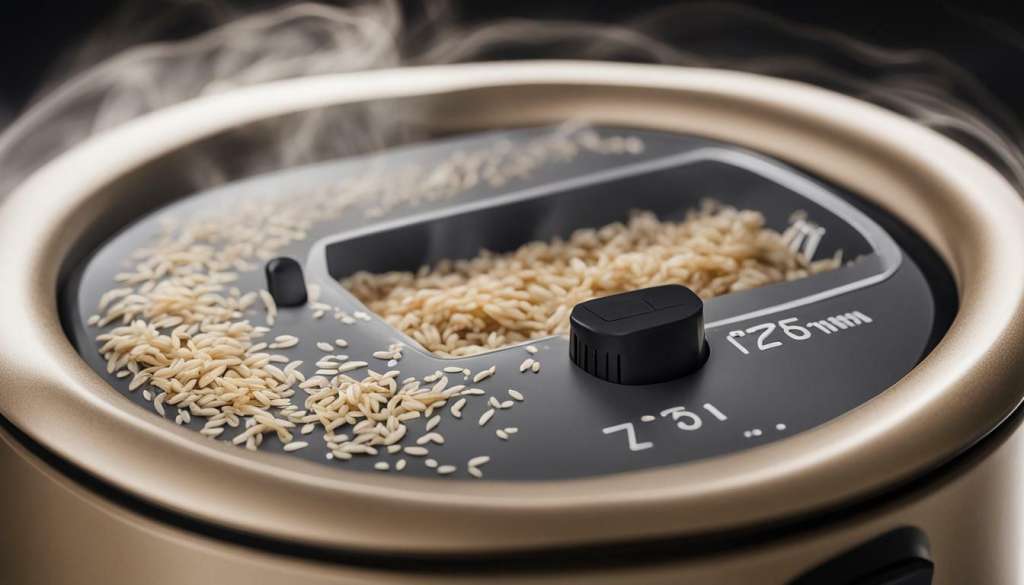
Pro Tip: To avoid timer-related issues, start by setting the timer for a shorter duration than expected and monitor the cooking progress. You can always add more time if needed.
Common Mistakes to Avoid When Using a Rice Cooker
If you’re finding that your rice cooker is burning your rice, it’s likely due to some common mistakes that many people make when using this kitchen appliance.
One mistake to avoid is not rinsing your rice before cooking. Rinsing rice removes excess starch and debris that can result in burnt rice or an unappetizing texture. Another mistake is adding too much water, which can lead to overcooked, mushy rice. Always follow the recommended water-to-rice ratios for the specific type of rice you’re cooking.
Another common mistake is not properly measuring the rice. Using too much or too little rice can affect the cooking time and water ratio needed for optimal results. Additionally, using the wrong rice type for your recipe or not adjusting the cooking mode or settings on your rice cooker can lead to burnt rice.
Lastly, neglecting to clean and maintain your rice cooker can also result in cooking problems and burnt rice. Regularly cleaning your rice cooker can help to prevent residue buildup, clogs, and other issues that can impact its performance.
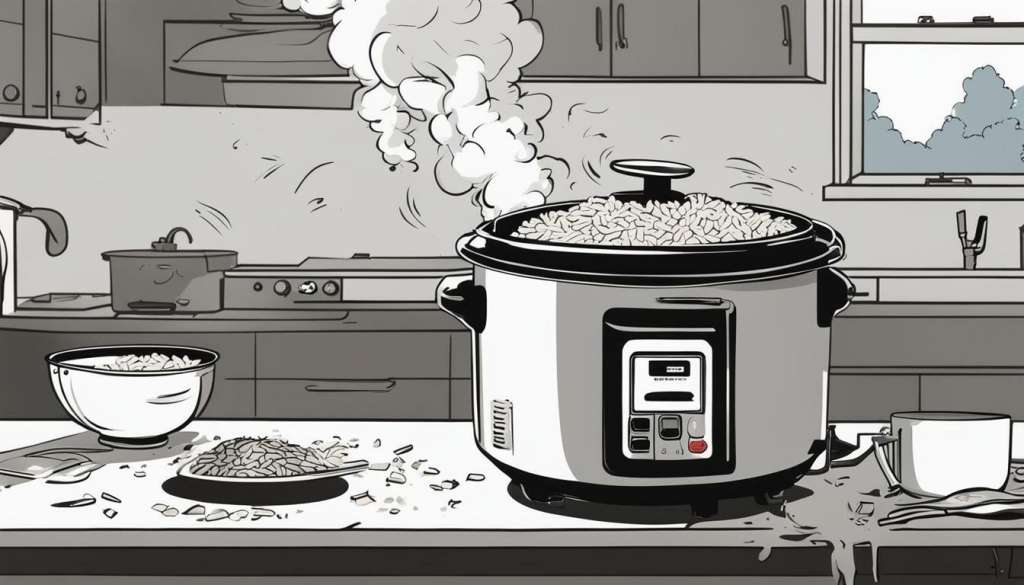
By avoiding these common mistakes and implementing the tips and strategies outlined in this article, you can achieve perfectly cooked rice every time with your rice cooker.
Tips and Solutions to Prevent Burnt Rice in Your Rice Cooker
Do you frequently encounter burnt rice when using your rice cooker? You’re not alone. Burnt rice is a common problem that many people face when cooking rice, but it doesn’t have to be. In this article, we’ve provided practical tips and solutions to help you avoid burnt rice and achieve perfectly cooked rice every time.
Understanding Rice Cooker Cooking Problems
Before we dive into solutions, it’s essential to understand the various cooking problems that can lead to burnt rice in a rice cooker. These problems can range from using the incorrect water ratio to selecting the wrong cooking mode. By identifying the cause of the problem, you can take steps to avoid it in the future.
Tips for Preventing Rice from Burning in a Rice Cooker
One of the most effective ways to prevent burnt rice is by adjusting the water ratio. Adding too much water to rice can lead to mushy and overcooked rice, while not enough water can cause dry and burnt rice. We also recommend using the correct cooking mode and following the manufacturer’s instructions. Additionally, you should regularly clean and maintain your rice cooker to ensure optimal performance.
Troubleshooting Common Rice Cooker Issues
If you’re already experiencing burnt rice, it’s crucial to troubleshoot and identify the problem. This might include checking the temperature and adjusting the cooking time. Sometimes, the issue might be a malfunctioning rice cooker, which requires repair or replacement.
Selecting the Right Rice Cooker for Preventing Burnt Rice
Choosing the right rice cooker can make a big difference in preventing burnt rice. Some brands are known for their superior performance and technical features that help prevent burnt rice. Factors to consider include the size, cooking modes, and ease of use.
Proper Cleaning and Maintenance of Rice Cookers
Cleaning and maintaining your rice cooker regularly is important to avoid burnt rice. This might include removing any residual rice grains, wiping down the interior of the pot, and decalcifying the rice cooker to prevent mineral buildup. Make sure to follow the manufacturer’s instructions for cleaning and maintenance.
Cooking Tips for Perfectly Cooked Rice
Aside from using the rice cooker correctly, there are additional cooking tips that can help you achieve perfectly cooked rice. For instance, thoroughly rinsing the rice before cooking can help remove excess starch and debris. Additionally, measuring the water accurately and using high-quality rice can also make a difference.
Exploring Rice Varieties and Water Ratios
Different rice varieties require varying amounts of water to cook correctly. Understanding the optimal water ratio for various types of rice can help you achieve the perfect texture and avoid burnt rice. Some types of rice may require more or less water, so it’s essential to research and adjust accordingly.
Adjusting Cooking Modes and Settings
Many rice cookers offer various cooking modes and settings that cater to different types of rice. For example, some types of rice may require a quick cook option instead of the regular cooking mode. Adjusting these settings correctly can help prevent burnt rice.
Troubleshooting Rice Cooker Timer Issues
If you’re experiencing issues with your rice cooker timer, it’s essential to troubleshoot and identify the problem. This might include resetting the timer or resetting the rice cooker itself. If necessary, you may need to consult the manufacturer’s instructions for further guidance.
Common Mistakes to Avoid When Using a Rice Cooker
Lastly, common mistakes can lead to burnt rice when using a rice cooker. Avoiding these mistakes, such as overfilling the pot or not cleaning it regularly, can make a significant difference in achieving delicious and perfectly cooked rice.
Conclusion
In conclusion, burnt rice is a common problem when using a rice cooker, but it’s not impossible to avoid. By following the tips and solutions provided in this article, you can achieve consistently great rice with every use. Remember to select the right rice cooker for your needs, follow manufacturer instructions, and regularly clean and maintain your rice cooker. With these insights, you can say goodbye to burnt rice forever.
FAQ
Q: Why does my rice cooker keep burning the rice?
A: There could be several reasons for your rice cooker burning the rice. It could be due to incorrect water ratios, cooking modes/settings, or timer issues. We recommend troubleshooting these factors to achieve perfectly cooked rice.
Q: How can I prevent rice from burning in my rice cooker?
A: To prevent rice from burning in your rice cooker, make sure to adjust water ratios according to the type of rice you are cooking. Additionally, utilize the appropriate cooking modes and settings, and avoid common mistakes such as using the wrong rice variety.
Q: What are some common issues that can lead to burnt rice in a rice cooker?
A: Common issues that can result in burnt rice include overheating, incorrect settings, and timer malfunctions. Troubleshooting these problems will help ensure your rice cooker functions optimally and produces perfectly cooked rice.
Q: Can you recommend some rice cooker brands known for preventing burnt rice?
A: Yes, there are several rice cooker brands known for their ability to prevent burnt rice. Some popular options include Zojirushi, Panasonic, and Tiger. When selecting a rice cooker, look for features such as advanced temperature control and fuzzy logic technology.
Q: How should I clean and maintain my rice cooker?
A: Proper cleaning and maintenance are essential for optimal rice cooker performance. Regularly clean the inner pot and exterior of the rice cooker with mild soap and water. Avoid abrasive cleaners and harsh scrubbing. Refer to your rice cooker’s manual for specific instructions.
Q: Do you have any additional cooking tips for perfectly cooked rice?
A: Absolutely! Along with rice cooker operation, rinsing the rice properly and measuring water accurately are important factors for achieving perfectly cooked rice. Additionally, allowing the rice to rest after cooking and fluffing it with a fork can improve the texture.
Q: How do different rice varieties require varying water ratios?
A: Different rice varieties have different levels of starch and moisture content, which affect their cooking time and water absorption. It’s important to follow the recommended water ratios for each rice variety to avoid burnt or undercooked rice.
Q: How do I adjust cooking modes and settings on my rice cooker?
A: Most rice cookers have various cooking modes and settings. Refer to your rice cooker’s manual to understand how to adjust them properly. Quick cook options, specific rice settings, and adjusting the cooking time can all help prevent burnt rice.
Q: What should I do if the timer on my rice cooker is not working?
A: If you’re experiencing issues with the timer on your rice cooker, try troubleshooting by checking the power supply, ensuring proper connections, and resetting the timer. If the problem persists, consult the manufacturer’s instructions or contact customer support for assistance.
Q: What are some common mistakes to avoid when using a rice cooker?
A: Some common mistakes to avoid when using a rice cooker include adding too much or too little water, not rinsing the rice properly, and opening the lid during the cooking process. By avoiding these mistakes, you can ensure consistently great rice.


